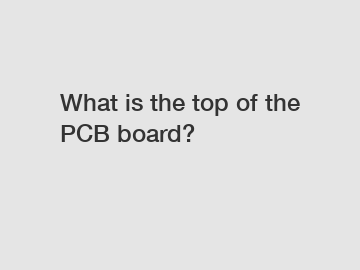What is the top of the PCB board?
What is the top of the PCB board?
One of the most important components of any electronic device is the PCB or Printed Circuit Board. It serves as the backbone of the device, connecting all the electronic components together. But have you ever wondered what is on the top surface of a PCB board? In this article, we will explore the top of the PCB board, its components, and their significance.
1. Components on the top surface:

When we look at the top side of a PCB board, we can see a variety of components that play crucial roles in the functioning of the electronic device. These components include resistors, capacitors, diodes, transistors, integrated circuits, connectors, and many more. Each component has a specific purpose and is placed strategically on the board to ensure efficient operation.
2. Placement and arrangement:
The placement and arrangement of components on the top surface of a PCB board are carefully designed to optimize functionality, connectivity, and reliability. The layout of the components is typically planned using specialized software, taking into consideration factors such as signal integrity, thermal management, and ease of manufacturing. This meticulous arrangement plays a vital role in the overall performance and reliability of the device.
3. Soldering and assembly:
Once the components are positioned on the top surface of the PCB board, they are securely attached using a process called soldering. Soldering involves melting a metal alloy (solder) to create strong electrical and mechanical connections between the components and the PCB traces. This ensures that the electrical signals can pass through the board without interference or loss of data.
4. Silkscreen and legends:
On the top surface of the PCB board, you may notice markings printed in white or other contrasting colors. These markings are known as silkscreen and legends. Silkscreen provides essential information about the component placement, orientation, and reference designators. Legends, on the other hand, provide additional information such as company logos, part numbers, and copyright notices. These markings assist technicians during assembly, testing, and troubleshooting processes.
5. Inspection and testing:
The top surface of a PCB board is also crucial during the inspection and testing stages of production. Technicians visually check the components and their placements to ensure accuracy, as any errors could result in faulty connections or malfunctioning of the device. Automated optical inspection (AOI) machines and X-ray inspections can also be used to detect potential defects in components' alignment, solder joints, and overall quality.
6. Protection and coating:
To protect the components and PCB traces from damage caused by environmental factors, a layer of coating or conformal coating is often applied to the top surface of the PCB board. This coating acts as a barrier, shielding the PCB from moisture, dust, chemicals, and temperature variations. It also enhances the overall durability and lifespan of the electronic device.
As we conclude this exploration of the top surface of a PCB board, it becomes evident that this seemingly straightforward aspect is much more than meets the eye. The components, their placement, and the meticulous manufacturing processes involved contribute to the functionality, reliability, and longevity of the electronic device. So the next time you come across a PCB board, take a moment to appreciate the intricate details hidden beneath the surface, and you will gain a deeper understanding of the complex world of electronics.
If you are looking for more details, kindly visit security product pcb board , automotive pcb design , Lead Free HASL PCB .

Comments
0